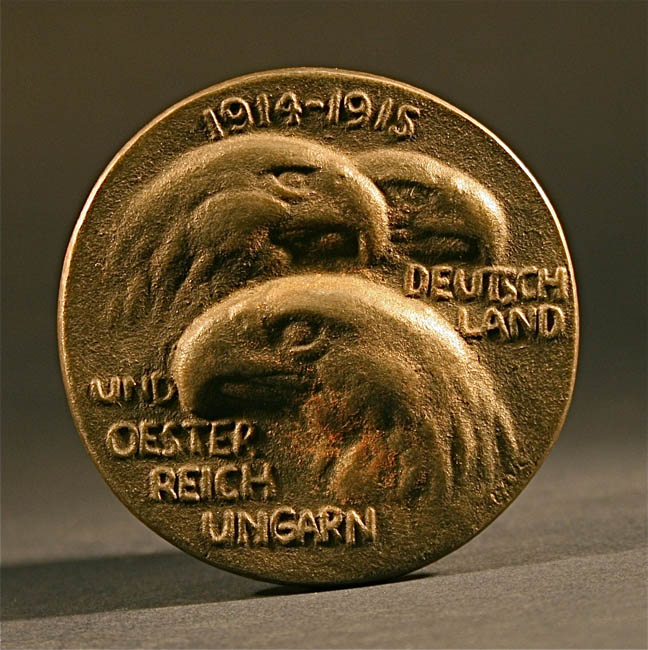

Title: Steel metal coin Heads of eagles 1914 1915 German War Art
Shipping: $9.00
Artist: N/A
Period: 20th Century
History: N/A
Origin: Central Europe > Germany
Condition: Museum Quality
Item Date: 1914 to 1915
Item ID: 3760
A large Steel coin of three heads of eagles 1914 1915 Deutschland Und Oester Reich Ungarn This looks like a coin or some kind of a metal from Germany. One side of this coin has three eagle heads, date 1914-1915 Deutschland Und Oesterreich Ungarn. The other side of the coin has two men Fighting. Zusammen Haltet Euren West - Und Euch Ist Nienand Gleich Goltne. Medallic Art. First World War. Germany. August Gaul (1869-1922), Iron Medal, 1915, heads of the three Eagles of Germany, Austria and Hungary, rev two naked warriors, swords raised, but facing away from each other, legend below (from Goethe), ZUSAMMEN HALTET EUREN WEST UND EUCH IST NIEMAND GLEICH, beaded border, 57.5mm (Goethe-Zitat 576). Extremely fine . August Gaul, sculptor, founding member of the Berlin Seccession, and famous for his sculptures of animals. In 1915 he served on the eastern front and many of his war drawings were published by Paul Cassirer, who also organised a major exhibition of his drawings in 1919 to mark his 50th birthday. War art is considered a genre of art. It is characterized by war, military subjects and war activities. The works described as war art represent a broad range of subject matter and styles. It includes sculpture, and other artistic media. War art includes painting, as a sub-type of history painting. Although war art is an account of one aspect of art history, it is also an expression of culture. War art combines artistic and documentary functions, and it becomes one of the significant legacies of any culture. War art by definition becomes an attempt to come to terms with the nature and reality of violence. For example, in Australia, C.E.W. Bean's Anzac Book influenced the artists who grew up between the two world wars. When these Australians were asked to depict a second multi-nation war after 1939, there was a precedent and format for them to follow.[ War art is typically realistic; but its definition of accuracy emphasizes not only factual, eyewitness detail but also the emotional impression and impact of events. War art is artwork conceived and executed by people involved in war in some manner. In other words, the subject can be parsed according to who creates it, as for example, • artists officially commissioned either to spend varying periods of wartime under fire or to be present at nearly every kind of military activity, in order to record them • servicemen-artists responding to powerful inner urges to depict direct war experience • sensitive onlookers
The history of war medals in Germany is a reflection of the country's complex and often tumultuous history. Germany, as a nation, has gone through various stages, and its medals have evolved accordingly. Here's an overview of the history of war medals in Germany: Napoleonic Wars: In the early 19th century, during the Napoleonic Wars, several German states and principalities were involved. Some issued medals to commemorate the bravery and service of their soldiers in these conflicts. These medals often featured the likenesses of rulers and military leaders. German Empire (1871-1918): The formation of the German Empire in 1871 under Emperor Wilhelm I brought about a standardized system of military awards and decorations. Notable medals and decorations included the Iron Cross (Eisernes Kreuz) and the Order of the Red Eagle. The Iron Cross, in particular, became a symbol of German valor and was awarded in various classes for different levels of bravery. World War I (1914-1918): World War I saw the issuance of numerous German medals and decorations. The Iron Cross was prominently featured, with various classes and variations depending on the level of distinction. Other medals, such as the Wound Badge and the Hindenburg Cross, were awarded for specific acts of valor or service. Weimar Republic (1919-1933): Following World War I and the collapse of the German Empire, the Weimar Republic issued various medals to veterans of the war. These medals were often associated with nationalist and patriotic sentiments. Third Reich (1933-1945): Under the Nazi regime, Germany introduced numerous medals and decorations, many of which were highly ideological and featured swastikas. The Iron Cross continued to be awarded, and other decorations, such as the War Merit Cross and the Knight's Cross of the Iron Cross, were introduced for acts of bravery and service. Post-World War II: After World War II and the defeat of Nazi Germany, many of the Nazi-era medals were discontinued, and the country underwent denazification. The Federal Republic of Germany (West Germany) and the German Democratic Republic (East Germany) issued their own medals and awards for military service and civilian achievements. Modern Germany: Following the reunification of Germany in 1990, the country has continued to issue medals and decorations to honor military and civilian service. These awards often have a more international and humanitarian focus. It's important to note that the history of German war medals is complex and intertwined with the nation's political and social history. The symbolism and significance of these medals have evolved over time, reflecting the changing ideals and values of the German state and society. Additionally, some Nazi-era medals and symbols are prohibited in Germany today due to their association with the atrocities of World War II.
Link: http://en.wikipedia.org/wiki/German_art
German art has a long and distinguished tradition in the visual arts, from the earliest known work of figurative art to its current output of contemporary art.
Germany has only been united into a single state since the 19th century, and defining its borders has been a notoriously difficult and painful process. For earlier periods German art often effectively includes that produced in German-speaking regions including Austria, Alsace and much of Switzerland, as well as largely German-speaking cities or regions to the east of the modern German borders.